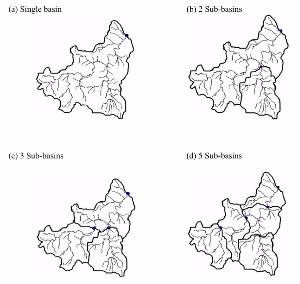Project 0-5822
Subdivision of Texas Watersheds for Hydrologic Modeling
Abstract
The purpose of this report is to present a set of findings and examples for subdivision of watersheds for hydrologic modeling. Three approaches were used to examine the impact of watershed subdivision on modeled hydrologic response: (1) An equal-area approach, (2) an ad-hoc approach wherein subdivisions were created at locations based on engineering judgment, and (3) a distributed-modeling approach. The three methods were implemented by different individuals with varied hydrologic experience, using their professional judgment under the direction of project researchers. Technology included NRCS curve number method for runoff volume, a variety of runoff-transformation methods, and use of measured rainfall-runoff responses. In general, subdivision had little or no impact on runoff volume. Estimates of peak discharge from study watersheds showed modest improvement in accuracy, but none beyond about 5-7 subdivisions. Time to peak estimates tended to degrade with subdivision, most likely because hydrologic routing introduced additional parameters requiring estimates. The distributed-modeling approach was extremely difficult to apply. In general, subdivision of watersheds is beneficial primarily when flow rates at locations internal to the watershed are required. The improvement in implied accuracy does not generally justify the subdivision process.

Project PI: David B. Thompson
Project Co-PI: Theodore G. Cleveland
Center for Multidisciplinary Research in Transportation (TechMRT)
-
Address
Texas Tech University, Box 41023, Lubbock, TX 79409-1023 -
Phone
806.742.3523 -
Email
techmrt.outreach@ttu.edu
